Sticky Postings
By fabric | ch
-----
As we continue to lack a decent search engine on this blog and as we don't use a "tag cloud" ... This post could help navigate through the updated content on | rblg (as of 09.2023), via all its tags!
FIND BELOW ALL THE TAGS THAT CAN BE USED TO NAVIGATE IN THE CONTENTS OF | RBLG BLOG:
(to be seen just below if you're navigating on the blog's html pages or here for rss readers)
--
Note that we had to hit the "pause" button on our reblogging activities a while ago (mainly because we ran out of time, but also because we received complaints from a major image stock company about some images that were displayed on | rblg, an activity that we felt was still "fair use" - we've never made any money or advertised on this site).
Nevertheless, we continue to publish from time to time information on the activities of fabric | ch, or content directly related to its work (documentation).
Thursday, April 09. 2015
Via Archdaily
-----
What if the manufacturers of the phones and social networks we cling to became the rulers of tomorrow’s cities? Imagine a world in which every building in your neighborhood is owned by Samsung, entire regions are occupied by the ghosts of our digital selves, and cities spring up in international waters to house outsourced laborers. These are the worlds imagined by self-described speculative architect, Liam Young in his latest series of animations entitled ”New City.” Read on after the break to see all three animations and learn more about what’s next in the series.
   

Viewers watching “The City in the Sea” at full size. Image Courtesy of Liam Young.
Liam Young’s London-based think tank Tomorrow’s Thoughts Today explores the “consequences of fantastic, speculative and imaginary urbanisms” through techniques of fiction and film, with extremely high definition animations accompanied by short stories written by Jeff Noon, Pat Cadigan and Tim Maughan. The imagery produced seeks to “help us explore the implications and consequences of emerging trends, technologies, and ecological conditions,” exploring emerging trends across media, technology, and popular culture in order to exaggerate them and better understand our own world alongside our future. The think-tank is being developed as a model for an architectural practice informed by research and speculation as products in and of themselves rather than buildings as final products. Animation is often employed by the think tank, as Liam Young tells ArchDaily:
“The skyline animations have been developed to be shown as super large scale projections, larger than the body so the audience has to move across the panorama, inhabiting it as they would do a city or building. Each animation is loaded with detail so as each time it is watched you might discover something different. The scale of the projections mean you are able to fully immerse yourself in the imaginary city and consumed by the soundscape you can sit and read the short story set in the city.”

From “Keeping up Appearances”. Image Courtesy of Liam Young
This latest series epitomizes many of the goals of the think-tank by looking at cites on a macro-scale and exaggerating trends across various stages of industry. The animations produced in the series thus far focus mainly on the technology sector and take existing cities as precedents for an exploration of themes and subsequent social commentary. For example, in the animation entitled “Keeping Up Appearances” (see top video) a future city is imagined in which almost every visible sign in the urban skyline is an advertisement for Samsung and the glowing logo represents the ownership of that particular piece of real estate. Based on a phenomenon occurring in many South Korean cities in which Samsung has begun to move into property development, in this exaggerated scenario the idea of corporate entities as driving forces behind real-estate development and growth becomes disturbingly plausible, while highlighting the real-world fact that many corporations have revenues which surpass the GDP of some countries. Young comments:
“The branded skyline is just the most visible consequence of our gadget allegiances. What I am suggesting is that our relationships to technology are in fact generating entirely new forms of city, and new notions of place or site itself. Where we are in the world matters far less now than how we are connected and who we are connected to. We now see new forms of city generated around operating system choices, who we like on facebook, our twitter network and so on. I am much closer to my virtual community than I am to my physical neighbors. The network has allowed ‘non state’ actors to permeate every aspect of our lives.”
The next video in the series, entitled “The City in the Sea,” looks at the very real issue of outsourced labor and industrialized cities in the developing world. Taken to its extreme in this animation, the imagined city is completely detached from any kind of nationalistic identity and only exists to provide a corporate haven for manufacturers that is devoid of regulations and taxes. According to Young:
“The City in the Sea is a multicultural city collaged from photos taken on expeditions through the outsourcing territories of India and China. The floating corporate city is built on the Pacific Ocean garbage patch and drifts in international waters, outside of national labor laws to become a free trade zone supporting the mega companies based on land. It is a city that connects to a long tradition of free states, from the traditions of pirate utopias, islands that existed with their own laws and governance to the speculations of offshore data havens on the abandoned naval fort Sealand or Google’s mysterious barges. We also see the same desires to escape jurisdiction playing out on land with the formation of special economic zones and free trade regions. These forms of territory are forcing us to reimagine what a border might mean in the age of the network.”
The third video in the series takes on a much more ephemeral quality and symbolically represents an element that is vital to our everyday lives, yet invisible to most. The idea of our online identity has become increasingly tangible to anyone that uses Facebook or surfs the web. Each of us possesses vast amounts of important information that is stored in “the cloud” but this notion has very little physical connection to our lives. Most are probably not aware of where their data is stored, but it is usually held in large data banks in places such as the city of Prineville, Oregon. These unassuming cities hold some of the world’s most sought after goods: personal identity stored digitally. Young also foresees data centers such as this as a new architectural frontier and describes its significance:
“This part of New City is built for machines, it is the physical landscape of the cloud, our generation’s cultural landscape. I am really interested in what these physical sites of the internet actually mean, they are a completely new cultural typology and architects need to take the data center on as a project. Is the internet a place to visit, are they sites of pilgrimage, spaces of congregation to be inhabited like a church on Sundays? Would we ever want to go and meet our digital selves, to gaze across server racks, and watch us winking back, in a million LEDs of Facebook blue? Every age has its iconic architectural typology. The dream commission was once the church, Modernism had the factory, then the house, in the recent decade we had the ‘starchitect’ museum and gallery. Now we have the data centre, the next forum for architectural culture.”

“The City in the Sea” on display at full size. Image Courtesy of Liam Young.
It is clear that the technology sector has already played a transformative role in our global economy, and Liam Young’s work gives us a glimpse at how technology may finally influence our built world. By illustrating these potential future scenarios and exaggerating them, Young opens a platform for discussion on how to take control of our own built world. But what is next in the series? What other pressing cultural issues require attention if we are to understand our built environment? Young tells ArchDaily:
“I am interested in continuing to look at the new types of ‘city’ that are emerging out of the network. Cities are increasingly being designed not for the people that occupy them but for the technologies and algorithms that are being built to understand them and manage them. Cities developed based around the logic of machine vision, satellite sight lines, Wi-Fi weather systems and so on are all of interest. These technologies are fundamentally changing what cities mean and these types of speculative projects are critical to play out possible scenarios for discussion.”
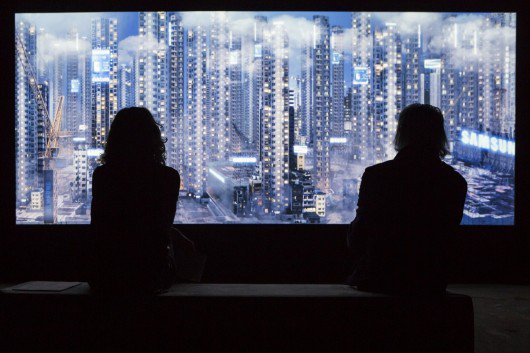
Viewers watching “Keeping Up Appearances” at full size. Image Courtesy of Liam Young
Readers can view all three animations accompanied with short stories by Jeff Noon, Pat Cadigan and Tim Maughan, at Liam Young’s Vimeo profile.
Wednesday, December 24. 2014
Note: Google Earth or literally and progressively Google's Earth? It could also be considered as the start of the privatization of the lower stratosphere, where up to now, no artifacts were permanently present.
Via MIT Technology Review
-----
Google X research lab boss Astro Teller says experimental wireless balloons will test delivering Internet access throughout the Southern Hemisphere by next year.
By Tom Simonite
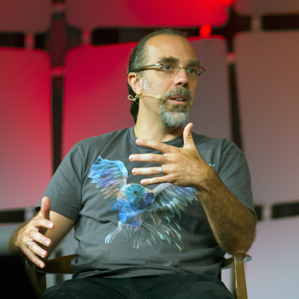 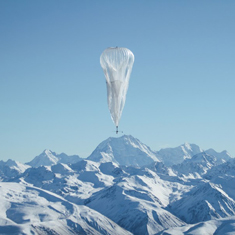
Astro Teller & a Project Loon prototype sails skyward.
Within a year, Google is aiming to have a continuous ring of high-altitude balloons in the Southern Hemisphere capable of providing wireless Internet service to cell phones on the ground.
That’s according to Astro Teller, head of the Google X lab, the company established with the purpose of working on “moon shot” research projects. He spoke at MIT Technology Review’s EmTech conference in Cambridge today.
Teller said that the balloon project, known as Project Loon, was on track to meet the goal of demonstrating a practical way to get wireless Internet access to billions of people who don’t have it today, mostly in poor parts of the globe.
For that to work, Google would need a large fleet of balloons constantly circling the globe so that people on the ground could always get a signal. Teller said Google should soon have enough balloons aloft to prove that the idea is workable. “In the next year or so we should have a semi-permanent ring of balloons somewhere in the Southern Hemisphere,” he said.
Google first revealed the existence of Project Loon in June 2013 and has tested Loon Balloons, as they are known, in the U.S., New Zealand, and Brazil. The balloons fly at 60,000 feet and can stay aloft for as long as 100 days, their electronics powered by solar panels. Google’s balloons have now traveled more than two million kilometers, said Teller.
The balloons provide wireless Internet using the same LTE protocol used by cellular devices. Google has said that the balloons can serve data at rates of 22 megabits per second to fixed antennas, and five megabits per second to mobile handsets.
Google’s trials in New Zealand and Brazil are being conducted in partnership with local cellular providers. Google isn’t currently in the Internet service provider business—despite dabbling in wired services in the U.S. (see “Google Fiber’s Ripple Effect”)—but Teller said Project Loon would generate profits if it worked out. “We haven’t taken a dime of revenue, but if we can figure out a way to take the Internet to five billion people, that’s very valuable,” he said.
Friday, September 14. 2012
Via MIT Technology Review
-----
Free services in exchange for personal information. That's the "privacy bargain" we all strike on the Web. It could be the worst deal ever.
By Cory Doctorow

Here's a story you've heard about the Internet: we trade our privacy for services. The idea is that your private information is less valuable to you than it is to the firms that siphon it out of your browser as you navigate the Web. They know what to do with it to turn it into value—for them and for you. This story has taken on mythic proportions, and no wonder, since it has billions of dollars riding on it.
But if it's a bargain, it's a curious, one-sided arrangement. To understand the kind of deal you make with your privacy a hundred times a day, please read and agree with the following:
By reading this agreement, you give Technology Review and its partners the unlimited right to intercept and examine your reading choices from this day forward, to sell the insights gleaned thereby, and to retain that information in perpetuity and supply it without limitation to any third party.
Actually, the text above is not exactly analogous to the terms on which we bargain with every mouse click. To really polish the analogy, I'd have to ask this magazine to hide that text in the margin of one of the back pages. And I'd have to end it with This agreement is subject to change at any time. What we agree to participate in on the Internet isn't a negotiated trade; it's a smorgasbord, and intimate facts of your life (your location, your interests, your friends) are the buffet.
Why do we seem to value privacy so little? In part, it's because we are told to. Facebook has more than once overridden the privacy preferences set by its users, replacing them with new system-wide defaults. Facebook then responds to the inevitable public outcry by restoring something that's like the old system, except slightly less private. And it adds a few more lines to an inexplicably complex privacy dashboard.
Even if you read the fine print, human beings are awful at pricing out the net present value of a decision whose consequences are far in the future. No one would take up smoking if the tumors sprouted with the first puff. Most privacy disclosures don't put us in immediate physical or emotional distress either. But given a large population making a large number of disclosures, harm is inevitable. We've all heard the stories about people who've been fired because they set the wrong privacy flag on that post where they blew off on-the-job steam.
The risks increase as we disclose more, something that the design of our social media conditions us to do. When you start out your life in a new social network, you are rewarded with social reinforcement as your old friends pop up and congratulate you on arriving at the party. Subsequent disclosures generate further rewards, but not always. Some disclosures seem like bombshells to you ("I'm getting a divorce") but produce only virtual cricket chirps from your social network. And yet seemingly insignificant communications ("Does my butt look big in these jeans?") can produce a torrent of responses. Behavioral scientists have a name for this dynamic: "intermittent reinforcement." It's one of the most powerful behavioral training techniques we know about. Give a lab rat a lever that produces a food pellet on demand and he'll only press it when he's hungry. Give him a lever that produces food pellets at random intervals, and he'll keep pressing it forever.
How does society get better at preserving privacy online? As Lawrence Lessig pointed out in his book Code and Other Laws of Cyberspace, there are four possible mechanisms: norms, law, code, and markets.
So far, we've been pretty terrible on all counts. Take norms: our primary normative mechanism for improving privacy decisions is a kind of pious finger-wagging, especially directed at kids. "You spend too much time on those Interwebs!" And yet schools and libraries and parents use network spyware to trap every click, status update, and IM from kids, in the name of protecting them from other adults. In other words: your privacy is infinitely valuable, unless I'm violating it. (Oh, and if you do anything to get around our network surveillance, you're in deep trouble.)
What about laws? In the United States, there's a legal vogue for something called "Do Not Track": users can instruct their browsers to transmit a tag that says, "Don't collect information on my user." But there's no built-in compliance mechanism—we can't be sure it works unless auditors descend on IT giants' data centers to ensure they aren't cheating. In the EU, they like the idea that you own your data, which means that you have a property interest in the facts of your life and the right to demand that this "property" not be misused. But this approach is flawed, too. If there's one thing the last 15 years of Internet policy fights have taught us, it's that nothing is ever solved by ascribing propertylike rights to easily copied information.
There's still room for improvement—and profit—in code. A great deal of Internet-data harvesting is the result of permissive defaults on how our browsers handle cookies, those bits of code used to track us. Right now, there are two ways to browse the Web: turn cookies off altogether and live with the fact that many sites won't work; or turn on all cookies and accept the wholesale extraction of your Internet use habits.
Browser vendors could take a stab at the problem. For a precedent, recall what happened to pop-up ads. When the Web was young, pop-ups were everywhere. They'd appear in tiny windows that re-spawned when you closed them. They ran away from your cursor and auto-played music. Because pop-ups were the only way to command a decent rate from advertisers, the conventional wisdom was that no browser vendor could afford to block pop-ups by default, even though users hated them.
The deadlock was broken by Mozilla, a nonprofit foundation that cared mostly about serving users, not site owners or advertisers. When Mozilla's Firefox turned on pop-up blocking by default, it began to be wildly successful. The other browser vendors had no choice but to follow suit. Today, pop-ups are all but gone.
Cookie managers should come next. Imagine if your browser loaded only cookies that it thought were useful to you, rather than dozens from ad networks you never intended to interact with. Advertisers and media buyers will say the idea can't work. But the truth is that dialing down Internet tracking won't be the end of advertising. Ultimately, it could be a welcome change for those in the analytics and advertising business. Once the privacy bargain takes place without coercion, good companies will be able to build services that get more data from their users than bad companies. Right now, it seems as if everyone gets to slurp data out of your computer, regardless of whether the service is superior.
For mobile devices, we'd need more sophisticated tools. Today, mobile-app marketplaces present you with take-it-or-leave-it offers. If you want to download that Connect the Dots app to entertain your kids on a long car ride, you must give the app access to your phone number and location. What if mobile OSes were designed to let their users instruct them to lie to apps? "Whenever the Connect the Dots app wants to know where I am, make something up. When it wants my phone number, give it a random one." An experimental module for Cyanogenmod (a free/open version of the Android OS) already does this.
Far from destroying business, letting users control disclosure would create value. Design an app that I willingly give my location to (as I do with the Hailo app for ordering black cabs in London) and you'd be one of the few and proud firms with my permission to access and sell that information. Right now, the users and the analytics people are in a shooting war, but only the analytics people are armed. There's a business opportunity for a company that wants to supply arms to the rebels instead of the empire.
Cory Doctorow is a science fiction author, activist, journalist, and co-editor of Boing Boing
Copyright Technology Review 2012.
Thursday, July 12. 2012
Via Creative Applications
-----
de Filip
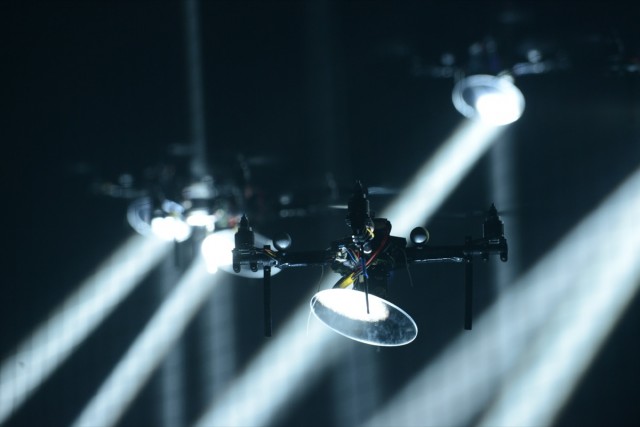
Now in its 22nd year, the Saatchi & Saatchi New Directors’ Showcase hit Cannes again, unveiling another presentation of the new directorial talent. Marshmallow Laser Feast (Robin McNicholas, Memo Akten and Barnaby Steel) were the creative and technical directors of the production which included a theatrical performance by 16 flying robots reflecting light beams on the stage. CAN got the all the details on how this mesmerising performance came into being.
Continue reading.... Quadrotors at the Saatchi & Saatchi New Directors Showcase 2012 by MLF – Details
Personal comment:
Although that it's branded (Saatchi) and in a typical "communication style" (the infamous "wow" effect of some marketing staff), the performance remains technically impressive. Especially the work of the robotic guys (KMel Robotics). A good address for future works!
We have a project with flying robots in the drawer for some times now (in fact since 2006... when we wanted to do something with blimps in the frame of a forthcoming research project).
Tuesday, July 19. 2011
Via Numerama
-----
Par Guillaume Champeau - publié le Lundi 18 Juillet 2011 à 10h39 - posté dans Télécoms
Les grands patrons des télécoms réunis par Bruxelles pour plancher sur les modes de financement du très haut débit à court terme dans l'Union Européenne ont accouché, sans surprise, d'une série de propositions qui enterrent la neutralité du net au profit d'un accès à plusieurs internets, plus ou moins riches selon l'abonnement payé. Des propositions qui enfoncent la porte déjà ouverte par la Commission Européenne.
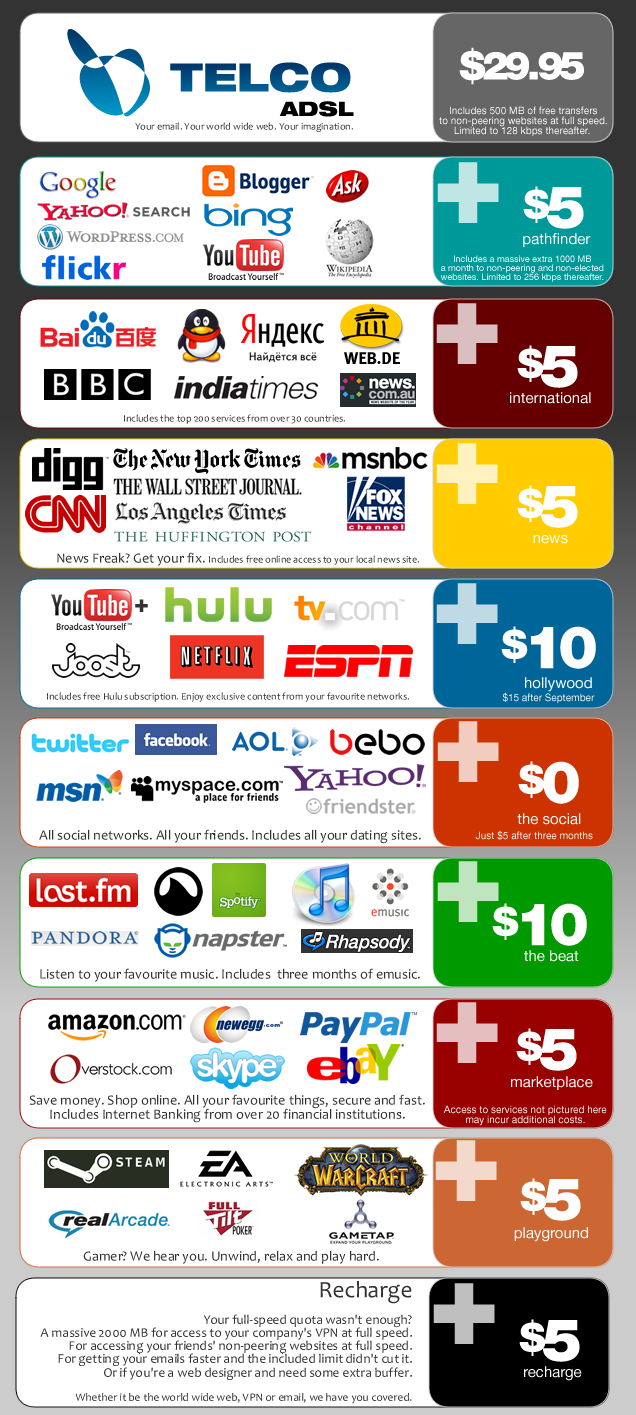 
Souvenez-vous. C'était en mars dernier. Sans grand bruit, la Commission Européenne réunissait à Bruxelles près d'une quarantaine de grands patrons des télécoms : Steve Jobs (Apple), Xavier Niel (Free), Stéphane Richard (Orange), Jean-Phillipe Courtois (Microsoft), Jean-Bernard Lévy (Vivendi), Stephen Elop (Nokia),..
La réunion avait pour but de demander aux industriels comment, selon eux, "assurer au mieux les investissements de très haut niveau du secteur privé nécessaires pour le déploiement des réseaux haut-débit de prochaine génération pour maintenir la croissance d'internet". La Commission souhaite en effet rendre possible l'objectif fixé par l'Agenda Numérique de l'Europe, qui prévoit que tous les Européens aient accès à Internet à 30 Mbps minimum d'ici 2020, et au moins la moitié d'entre eux à 100 Mbps.
Pour élaborer les propositions, un groupe de pilotage composé avait été désigné, composé par Jean-Bernard Lévy de Vivendi, Ben Verwaayen d'Alcatel-Lucent, et René Obermann de Deutsche Telekom. "Preuve qu'il y a dès la composition du groupe la volonté de trouver un équilibre entre le financement des réseaux et le financement des contenus, ce qui n'est jamais très bon signe pour la neutralité du net", pressentions-nous alors.
Le résultat est encore pire que nos craintes de l'époque, et confirme la tendance exprimée par la Commission Européenne le mois dernier, lorsqu'elle a dit vouloir privilégier le libre marché à la défense de la neutralité du net.
11 propositions pour enterrer la neutralité des réseaux
Lors d'une seconde réunion le 13 juillet dernier, les trois compères ont en effet remis une série de 11 propositions, insoutenables pour les partisans de la neutralité du net. Prenant l'objectif européen comme une aubaine pour prétendre que le déploiement du très haut-débit à court terme ne peut se faire sur les mêmes bases que précédemment, le groupe conclut que l'Europe "doit encourager la différenciation en matière de gestion du trafic pour promouvoir l’innovation et les nouveaux services, et répondre à la demande de niveaux de qualité différents". Il s'agit donc de faire payer plus cher ceux qui souhaitent accéder sans bridage à certains services qui demandent davantage de bande passante, ou "une moindre latence, ce qui est capital dans le jeu vidéo", explique le patron de Vivendi à la Tribune.
Il est aussi clairement envisagé de permettre aux éditeurs de services d'acheter un accès privilégié aux abonnés à Internet, pour que leur service soit plus rapide que celui des concurrents qui ne paieraient pas la dîme. "La valorisation du potentiel des marchés bifaces apportera plus d’innovation, d’efficacité et un déploiement plus rapide des réseaux de nouvelle génération, au bénéfice des consommateurs et des industries créatives", croit pouvoir affirmer le groupe de travail.
Par ailleurs, il justifie l'absence de représentants d'organisations de citoyens et de consommateurs parmi la quarantaine de dirigeants consultés par Bruxelles. "Les intérêts à long terme des consommateurs coïncident avec la promotion de l’innovation et l’investissement". Ils n'ont qu'à subir la mort de la neutralité du net, c'est au final dans leur intérêt, assurent les patrons des télécoms.
Dans La Tribune, Jean-Bernard Lévy raconte que la réunion du 13 juillet s'est "formidablement mieux passée que l'on ne pensait", et qu'elle a parmi de découvrir "un degré de consensus remarquable et inattendu entre ces acteurs de toute la chaîne de valeur, opérateurs, fabricants, agrégateurs, éditeurs de chaînes, etc". En oubliant, au passage, que les internautes sont les premiers acteurs de cette chaîne de valeur. Non seulement parce qu'ils payent leur accès à Internet. Mais aussi parce qu'ils sont aujourd'hui, et de très loin, les premiers producteurs des contenus qui y circulent.
Personal comment:
This can't be good... (Thanks Nicolas for the link)
Wednesday, January 26. 2011
Via TreeHugger
-----
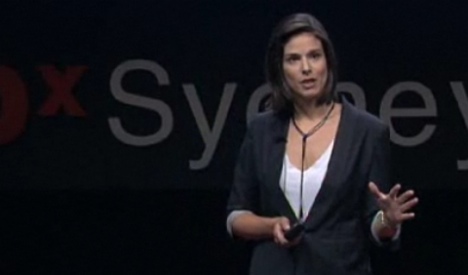
Image via TED
The rise of lending libraries, swapping sites, and product as a service systems over the last 5 years or so has been impressive. We've seen an upswing in everything from clothing swap parties to local rental communities, to big services like Zipcar for getting around without having to own a car and even AirBnB for renting spare bedrooms from locals rather than hotel rooms. Rachel Botsman is the co-author of the book What's Mine Is Yours: The Rise of Collaborative Consumption. She studies how we're switching to a culture of sharing, and how that will transform business, consumerism, and the meaning and impact of social networking in our lives. She took the time to answer a few questions from us about what's behind collaborative consumerism, and what we can expect over the next few years.
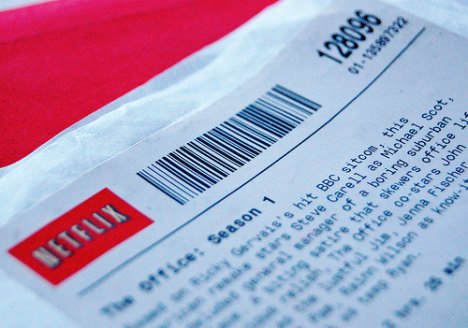
Photo by Jamiesrabbits via Flickr Creative Commons
Lending libraries, rental sites for stuff, and even car sharing is getting more popular these days. But what area of consumables have you seen the most growth in for sharing or swapping among community members?
Swapping sites for goods with limited value or that fulfill a temporary need such a baby goods, books and DVDs are growing at a staggering rate; Peer-to-peer space rental sites (homes, gardens, parking spaces, storage etc.) such as AirBnb, Landshare and Parkatmyhouse are exploding in mainstream popularity; Bike sharing is the fastest growing form of transportation in the world; Co-working spaces are popping up in the world's major cities; I think 2011 is the year that we start to see skill or 'favor' share communities such as TaskRabbit, Skillshare and Hey Neighbor start to take off.
As collaborative consumerism becomes more practical and popular, how do you think it will shift our economy as a whole?
Big picture (and I am talking in 10-20 years time), I think we will see the way we measure 'wealth', 'growth' and 'happiness' being completely redefined. We are already seeing countries such as the UK, Canada and France looking at reinventing measures beyond GDP that give a picture of the holistic well-being of a nation. As Sarkozy commented, "So many things that are important to individuals are not included in GDP."
The way assets and income are taxed is going to be an interesting area as more people become "micro-entrepreneurs" earning money renting out their assets or bartering their skills. Peer-to-peer marketplaces essentially cut out a lot of middlemen but in the process create a whole array of cottage industries. Just think of Etsy. It's going to be interesting to see whether big brands and global businesses retain their appeal or whether small really is the next big thing.
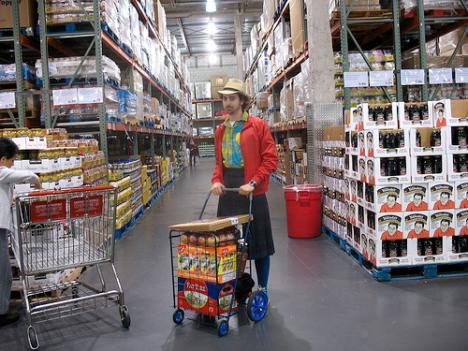
Photo by Orin Zebest via Flickr Creative Commons
Some of the big environmental benefits we can see with a culture of sharing goods is reduced production of stuff, and definitely less waste. What are some of the lesser seen eco-benefits we might see?
In short, a) better utilization of assets b) products designed for longevity not obsolescence and c) mindset and behavior change.
All around us, we are surrounded by stuff that has what I call 'idling capacity', the untapped value of unused or underused assets. There are different kinds of idling capacity. Products that are underutilized (e.g. the average car that sits parked for 23 hours a day); products that fulfill a temporary need (e.g. baby goods and clothes): or those that diminish in appeal and value after usage (e.g. a movie or a book). At the heart of Collaborative Consumption is how we can use the latest technologies to redistribute 'idling capacity' and maximize usage.
I could not think of a more exciting time to be a designer. Longevity does not just mean designing with durable materials but making goods with modularity that can be seamlessly updated, as well as easily broken down for future reuse, resale or repair. It will mean designing products that can be easily shared, customized and personalized by different users. If a designer had a blank sheet of paper and was designing a car for shared usage versus individual ownership how would it differ? How can we use RFID tags to embed stories, images, and videos into shared goods so they become smarter and more interesting than individually owned products? There are endless sustainable design opportunities...
When people start using different examples of Collaborative Consumption they frequently describe a 'mindset change.' There are examples like car sharing where users think twice about whether they need to drive and thereby reduce their miles travelled by an approximated 45%. And there are examples like peer-to-peer rental, where people are using platforms such as Neighborgoods or Snapgoods. 'Owners' are realizing they can make money from renting out their assets peer-to-peer and 'renters' are experiencing the benefits of not needing to own. Finally, you have examples like 'swap trading' where people suddenly realize they are surrounded by assets they can swap to get what they want versus buying new stuff. The behaviour becomes addictive.
How far do you think we are from having collaborative consumerism be a mainstream way of using goods, and what are some of the steps we still need to take to get there?
We are just in the nascent stages of Collaborative Consumption. We have already seen examples like Netflix, eBay and Zipcar become household names but that has taken a decade - technology and consumer values were playing catch-up. But I think the current massive cultural and technological shift is accelerating the next wave of Collaborative Consumption at an astonishing rate.
I think it's critical for more big brands to enter the space. BMW, Daimler and Peugeot have all recently launched car sharing models. Amazon just announced its 'Buy Back' scheme of second-hand unwanted books. I would love to see a big bank enter the social lending space; for a retail giant like Target to launch an innovative rental model; for a brand like Zappos to create a shoe swapping and repair platform....
Big brands can reach scale faster, they prove there are real business models behind Collaborative Consumption (and there are), but they also create the social proof, the cultural cache for this new cultural and economy to become mainstream.
More on Collaborative Consumerism
Meet Rachel Botsman and Roo Rogers Authors of What's Mine Is Yours
TED Talk: Systems of Sharing About to Revolutionize Consumerism
|
















